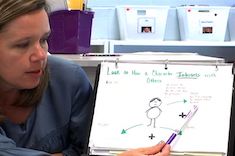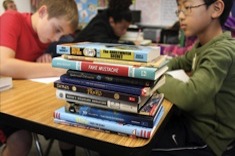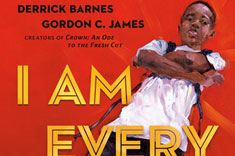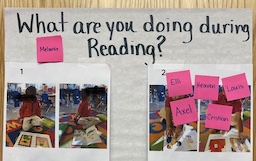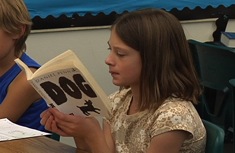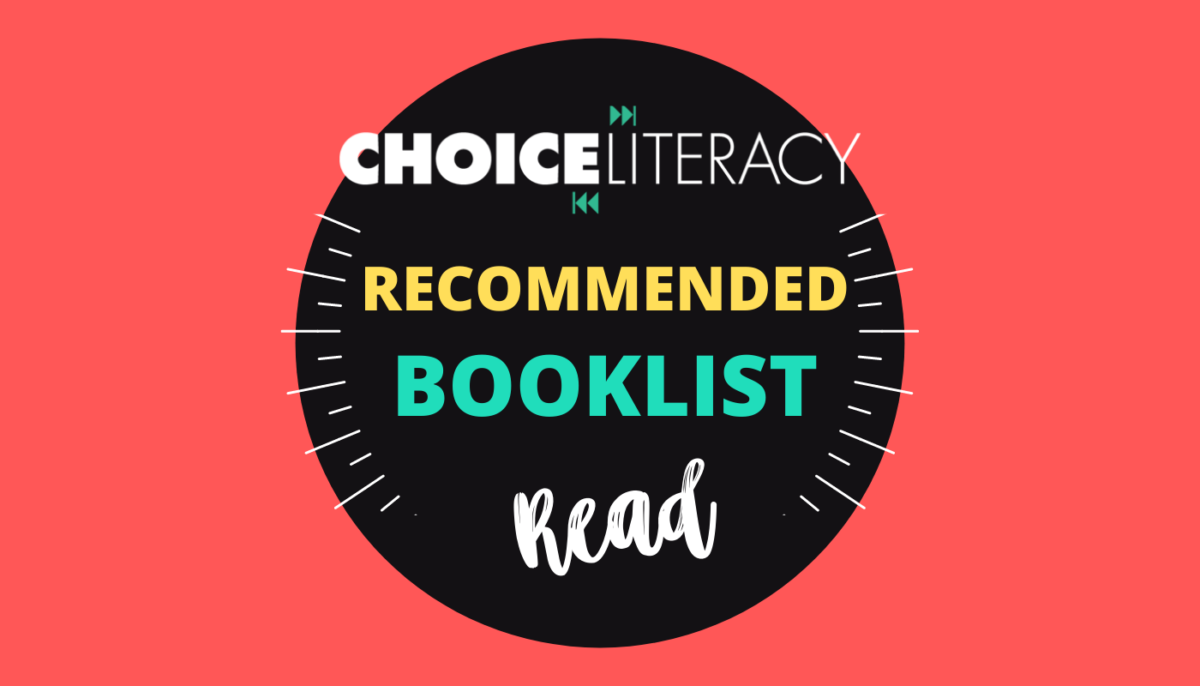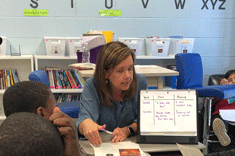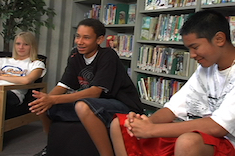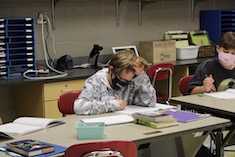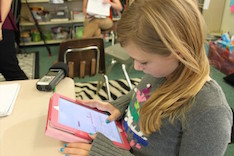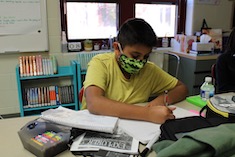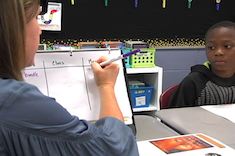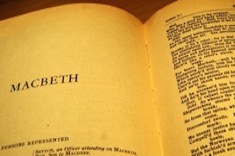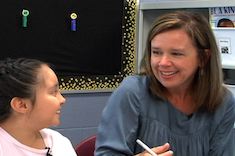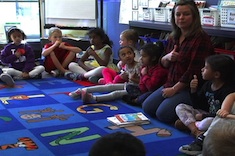Teaching Reading
Our contributors lead reading workshops in classrooms with creative flair. Over the past 12 years, we've filled our site with loads of suggestions, tools, and tips for using engaging books throughout the curriculum to hook kids on reading. Here is where you will find many stories of successful and not-so-successful workshop days, and what we learned from them. We bring these stories to life through hundreds of video examples.
Latest Content
My Teaching Toolbox (Part 1)
Every now and then we make the classic teaching mistake: assign rather than teach. Dana Murphy curated her favorite teaching tools that help her stay inspired to continually teach students. This is part one of a two-part series.
Does Gender Impact Reader Engagement?
Gretchen Schroeder questions whether the protagonist’s gender influences her students’ engagement with a text. Using the dystopian novel Legend, which has two protagonists of different genders, Gretchen gathered feedback from her students. What she discovered was that a reader’s engagement with a text has more to do with empathy than with gender. You’ll love Gretchen’s new way of selecting whole-class texts for her students.
Holding Space for Counter-Narratives That Honor Communities
Stella Villalba guides us to expand the counter-narrative texts we use in our classrooms. Counter-narrative texts challenge the stereotypes often seen about a group of people, and they celebrate the joy and resilience of a community. Stella provides a list of critical questions that allow us to deeply explore texts, as well as suggestions of books to read.
Considering Positionality and Developing New Sight Lines
Gretchen Schroeder shares a powerful approach to reading response to help students consider their positionality in a scene. Your identity, your thoughts, and your experiences influence the way that you relate to a text. This is your positionality as a reader, and it’s important to consider your positionality within a text because it explains how and why we come to certain conclusions as we read.
Partnering with Families on Reading
Tara Barnett and Kate Mills share ways to make families partners in the pursuit of creating lifelong readers. They share research that makes a case for “just” reading and compelling suggestions for families to support their children’s reading lives.
Creating Learning Progressions with Students
Tara Barnett and Kate Mills outline the steps to involve students in defining how to progress as readers and then set goals. They offer a practical plan for empowering students to take ownership of their learning.
Getting Ready to Read
Dana Murphy encourages us to go beyond teaching students to recognize different genres by helping them establish expectations of genres so they’ll be ready to read.
Emoji Book Talks
Jen Vincent outlines a twist on book talks—the Emoji Book Talks. This is a fast and fun way for students to share books and build their Books to Read lists.
Middle School Reading Routines
Tara Barnett and Kate Mills share ways to establish middle school reading routines. They share two downloads to help support reading routines in all classrooms.
Managing Your Students’ Independent Work During Guided Reading
Are you ready to ditch small-group instruction because it seems too difficult for students to work independently? Lisa Mazinas compiled a helpful chart to problem solve common classroom issues and support student independence.
Small-Group Conversations About Independent Reading
Jen Vincent scaffolds conversations to help students discuss their independent reading books in small groups…even when everyone is reading a different book! Download and print a copy of the guide to support students in their small-group conversations.
Energizing Early Readers: The Classroom Library as a Co-Teacher (Booklist)
Ruth Metcalfe shares a fun-loving and inspiring early reader booklist to help boost reading energy in her classroom library.
Five Ways to Teach Fluency
Dana Murphy reminds us of five ways to teach fluency…especially when reading seems laborious.
Validating Students
When an excited young reader interrupts the quiet hum of reading workshop, Becca Burk analyzes the important unseen choices students make as learners, and the powerful messages teachers’ responses send.
Rural Matters: Revealing Perceptions and Celebrating Roots
Gretchen Schroeder addresses the negative and positive perceptions of rural people with her high school students through readings, discussions, and analytical writing. Download a guide for Critical Rural Perspective Analysis to use with your students.
Assessing High School Readers
Secondary instructional coach Holly Wenning shares ways to assess high school readers.
Assessment in Classroom Book Clubs
In this third installment about classroom book clubs, Leigh Anne Eck shares options for robust assessment as well as answers to some frequently asked questions.
Identifying Story Elements
Dana Murphy shares a whole-class conversation about identifying the climax of the plot. She reminds us that defining story elements is not always clear-cut.
Implementing Classroom Book Clubs (Part Two)
In this second installment about book clubs, Leigh Anne Eck shares procedures for book club meetings, as well as discusses the importance of standards and instruction. Download a discussion guide.
Teaching Readers Rather Than Teaching Books
Secondary instructional coach Holly Wenning shares her own paradigm shift of teaching readers rather than teaching books, and encourages all teachers to consider the importance of putting students before books when planning literacy instruction.
Getting Started with Classroom Book Clubs (Part 1)
In the first installment of a three-part series, Leigh Anne Eck clearly lays out how to get started with book clubs. Included is an editable planning bookmark to give students more ownership of their reading schedules.
Less Is More: Using Novels in Verse in the Classroom
Gretchen Schroeder explains the reason why she believes requiring high school students to read novels in verse during independent reading time is worthwhile for their reading identity and developing more sophisticated understandings of literary analysis.
Expanding the Definition of “Text”
Holly Wenning helps us expand the definition of text when considering mentor texts and reading assessments.
The Importance of the Workshop Model in High School
Instructional coach Holly Wenning shares the importance of the workshop model, and especially work time, for high school students. See the transition from minilesson to work time in a 10th-grade English class.
The Power of an Anchor Chart in a Digital World
Dana Murphy reminds us of the power of an anchor chart in a digital world.
Spoiler Alert: You Can Start Big to Go Small (Macbeth in One Class Period)
Gretchen Schroeder confesses her fast-paced approach to sharing Macbeth with her high school students. Starting with the big picture of the story and then drilling down into specific scenes for skill practice not only accomplished the goals for the unit, but also freed up more time and space for other curriculum needs.
Engaging Kids in Reading Intervention
Dana Murphy shares ways to make reading intervention a high-interest time for students.
Questions to Ask When Reading the Morning Message
Tammy Mulligan guides teachers in a progression to help students identify tricky words, move deeper into word analysis, and develop inferential thinking. Included is a helpful progression chart to guide teachers in helping all students understand that readers encounter problems and can solve the tricky words.
Building a Classroom Library with Students (and Navigating the Tricky Parts)
Tammy Mulligan leads us through the process of giving primary students the reins for building and organizing the classroom library . . . and offers tips for navigating the tricky parts.
Spontaneous Text Sets
Bitsy Parks wanted to create an intentional read aloud routine that responded to student interests and needs as readers. She shares the way her responsive selection of books led to spontaneous (and powerful) text sets.
Browse Content By
Type
Category
- Assessment Tools
- Big Fresh Archives
- Booklists
- Choice Numeracy
- Classroom Design
- Common Core
- Community Building
- Conferring
- Content Literacy
- Digital Literacy
- English Language Learners
- Equity
- Family Relations
- Free Samples
- Guiding Groups
- Leadership
- Literacy Coaches
- Mentor Texts
- Minilessons
- New Teacher Mentors
- Podcasts
- Poetry
- Quote Collections
- Reading Strategies
- Self Care
- Struggling and Striving Learners
- Talking and Listening
- Teacher Study Groups
- Teaching Reading
- Teaching Writing
- Word Study and Vocabulary
Author
- Melissa Quimby
- Nawal Qarooni
- Gwen Blumberg
- Julie Cox
- The Lead Learners
- Hannah Tills
- Josie Stewart
- Ruth Metcalfe
- Mallory Messenger
- Becca Burk
- Jodie Bailey
- Vivian Chen
- Mary Brower
- Tiffany Abbott Fuller
- Stephanie Affinito
- Ruth Ayres
- Leigh Anne Eck
- Heather Fisher
- Shari Frost
- Julie Johnson
- Suzy Kaback
- Gigi McAllister
- Shirl McPhillips
- Melanie Meehan
- Cathy Mere
- Debbie Miller
- Tara Barnett and Kate Mills
- Tammy Mulligan
- Dana Murphy
- Bitsy Parks
- David Pittman
- Brenda Power
- Heather Rader
- Matt Renwick
- Mandy Robek
- Christy Rush-Levine
- Gretchen Schroeder
- Jen Schwanke
- Brian Sepe
- Katherine Sokolowski
- Stella Villalba
- Jennifer Vincent
Grade Level
Choice Literacy Membership
Articles
Get full access to all Choice Literacy article content
Videos
Get full access to all Choice Literacy video content
Courses
Access Choice Literacy course curriculum and training

